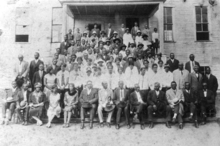Conroe Normal and Industrial College (1903–1981) was a private co-educational vocational school and normal school for African American students, founded in 1903 in Conroe, Texas, United States.[1] The school also went by the names Conroe Baptist Theological Institute,[2] and Conroe College.[3]
History

Conroe Normal and Industrial College was established in April 1903, by founding president Jimmie Johnson.[2] Johnson fundraised for the formation of the school through extensive travel within Texas and lecturing; he solicited for funds from black churches, black associations, and black conventions.[2]
Johnson and his wife were among the small number of early teachers at the school in the early years. David Abner Jr. took over as the second president.[2][4] William A. Johnson served as the third president.[2]
It was on 10th Street. Its five-story main building burned in 1915 and a new two-story building constructed for it.
The school had a lot of land, approximately 105 acres which was an active farm that students worked on tending livestock, growing crops, and indoor domestic work.[2][5] Boys and girls were taught at the school separately, and were required to wear uniforms.[2][5]
In the 1980s, the school was one of the organizational locations for the "Free Clarence Brandley" movement.[3]
In October 2014, the Conroe Baptist Theological Institute deeded the remaining 20-plus acre campus to a private investor.[2]
Presidents
Archives and legacy
UTSA Libraries has a 1947 photograph of Baptist ministers in front of the school.[8] TCU Libraries have a collection of photographs, interviews, and documents about the school.[9]
In 2017, Robin Navarro Montgomery and the Montgomery County Historical Commission were working on adding a state historical marker to the 10th Street location.[2] In 2021, plans were announced to restore the one remaining college building into a youth community center.[10]
See also
References
- ^ "Roots of Conroe Normal and Industrial College". The Courier. August 28, 2012.
- ^ a b c d e f g h i Hernandez, Sondra (April 3, 2017). "Early educators dedicated to bringing opportunity for all". The Courier.
- ^ a b Krochmal, Max; Moye, Todd (2021-11-09). Civil Rights in Black and Brown: Histories of Resistance and Struggle in Texas. University of Texas Press. p. 446. ISBN 978-1-4773-2381-6.
- ^ Montgomery, Robin (18 July 2020). "Seattle, Huntsville, Conroe and the rest of the story". Itemonline.com.
- ^ a b Foerster, Sondra Bosse Hernandez, Dr Robin Montgomery, Joy Montgomery and Larry (2021). Conroe. Arcadia Publishing. p. 93. ISBN 978-1-4671-0599-6.
{{cite book}}: CS1 maint: multiple names: authors list (link) - ^ "Harmony Among Negro Baptists". The Galveston Daily News. 1910-09-20. p. 9. Retrieved 2023-04-09.
- ^ a b c d e f g h The History of Conroe Normal and Industrial College (1903–1981) (PDF). 1981.
- ^ "Baptist ministers outside Conroe Normal and Industrial College, 1947". UTSA Libraries.
- ^ "Conroe Normal and Industrial College (2) [tax exemption denied], 2001-2013". TCU Libraries. Texas Christian University.
- ^ Vigh, Eva (March 25, 2021). "Historic Black college in Conroe to become youth community center". impact.


Recent Comments